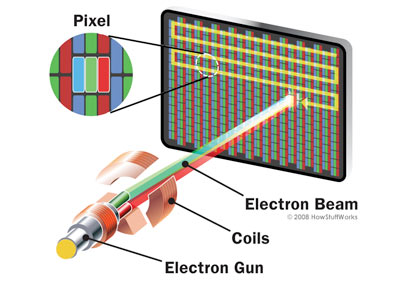

Manufacturers also must maintain records of test data and prepare an annual report to FDA summarizing these records. These reports contain a description of the manufacturer’s quality control and testing program and the television radiation safety design.
Cathode ray tube tv tv#
All TV manufacturers must submit written radiation safety reports to FDA outlining how they assure that each set coming off the assembly line complies with the Federal x-ray radiation limit.

Cathode ray tube tv code#
Manufacturers of television receivers and computer monitors contain CRTs must certify that their products meets performance standard under Title 21 of the Code of Federal Regulations (CFR) Part 1020.10. Test conditions do not represent normal use and ensure that when used under normal conditions, TV sets do not pose a radiation hazard.Īssuring That TV Sets Meet the Radiation Standard The overall effect of the standard is to require that TV receivers must not emit x-radiation above the 0.5 mR/hr level when tested under adverse operating conditions. The standard is applicable to all TV sets manufactured after January 15, 1970. Through it's Center for Devices and Radiological Health, FDA sets and enforces standards of performance for electronic products to assure that radiation emissions do not pose a hazard to public health.Ī Federal standard limiting x-ray emissions from TV receivers to 0.5 milliroentgen per hour (mR/hr) was issued on December 25, 1969. The Food and Drug Administration (FDA) has the responsibility for carrying out an electronic product radiation control program mandated by the Electronic Product Radiation Control provisions of the Food Drug and Cosmetic Act. It should be emphasized that most TV sets have not been found to give off any measurable level of radiation, and there is no evidence that radiation from TV sets has resulted in human injury. It was for this purpose that Congress enacted the Radiation Control for Health and Safety Act of 1968 (currently called Federal Food, Drug, and Cosmetic Act – Subchapter C – Electronic Product Radiation Control). It is advisable, therefore, that x-radiation from TV sets, as well as other commonly used electronic products, be kept as low as reasonably achievable. However, the current assumption is that there is no threshold of exposure below which x-radiation may not adversely effect human health. Scientists have not identified specific health effects resulting from exposure to extremely low doses of low-level radiation over prolonged periods of time. This unintentional emission of x-radiation can pose a potential hazard and must be controlled. These components may produce x-rays capable of escaping from the television receiver or CRT. Since many of the components in television sets operate at thousands of volts, there is the potential for x-ray generation. X-rays may be produced when electrons, accelerated by high voltage, strike an obstacle while traveling in a vacuum, as in a TV containing a cathode ray tube (CRT). In others, as with TV sets, radiation emitted is not intentional and is not essential to the use of the product. In some cases, as with diagnostic x-rays, radiation emitted from these devices is intentional and serves a useful purpose.

These include diagnostic x-ray machines, television sets, microwave ovens, radar devices, and lasers. Much of the manmade radiation people are exposed to comes from electronic products. We are also exposed to manmade radiation, which can and must be controlled. This is called background radiation and cannot be controlled. We are surrounded by natural radioactivity in the earth and by cosmic rays from outer space. Man cannot escape exposure to some radiation. Putting Television Radiation in Perspective Assuring That TV Sets Meet the Radiation Standard.Putting Television Radiation in Perspective.


 0 kommentar(er)
0 kommentar(er)
